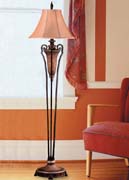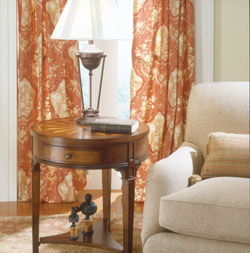 To adequately fill a room with light, ambient and task lighting are needed. Ambient light comes from a single source, like natural light, whereas task lighting is used to light a specific area such as a desk, workbench, reading chair or kitchen surface.
To adequately fill a room with light, ambient and task lighting are needed. Ambient light comes from a single source, like natural light, whereas task lighting is used to light a specific area such as a desk, workbench, reading chair or kitchen surface.
Adding a little light to your respective living areas seems like a simple task, provided that you consider some of the factors affecting which lamp fixture you should buy.
How to Choose the Right Lamp
Many people choose a lamp without first taking measurements and considering both the style and the purpose of the lamp. Size, brightness, and look are very important when purchasing any type of home lighting, but lamp fixtures are especially particular because they serve the dual purpose of providing light and decorating the room. Before you go hunting for a new lamp, be prepared with a few helpful hints.
The size of the lamp is possibly the most important matter to determine. This is somewhat dependant on how the lamp will be used.
 Will this lamp sit on the floor or on a table? Will it be used for reading? Where will the lamp be positioned in the room? If the lamp is going to be placed on a table, it must have the right proportions so that the lampshade does not overlap the edges of the table. This not only prevents the lampshade from being bumped, but also allows for a few more objects to be placed on the table for display.
Will this lamp sit on the floor or on a table? Will it be used for reading? Where will the lamp be positioned in the room? If the lamp is going to be placed on a table, it must have the right proportions so that the lampshade does not overlap the edges of the table. This not only prevents the lampshade from being bumped, but also allows for a few more objects to be placed on the table for display.
The materials and styles of lamps are the most flexible options. The style of the lamp does not have to completely match that of the room. As long as the finish of the fixture is complimentary or matching to the surface the lamp will rest on, the material can be chosen by taste. To narrow the search, decide on a contemporary or traditional style and proceed by finding the right size and proportion. Keep it in scale. A delicate table deserves a delicate table lamp. Likewise, a table with mass needs to have a lamp with substance.
Picking the right lamp fixture may be the final factor in the success of your home lighting. Lamps are crucial decorative pieces that must provide the light you need while tying the room design together. Take the time to measure precisely and choose wisely.
Think of lighting in layers. Don't make the mistake of thinking that one overhead fixture is all you need in a room. Having multiple sources of light in a room will allow you to change the level of light for specific needs. Rooms typically need five to seven sources of illumination to be fully functional and look their best. The layers can include natural light, overhead fixtures, table lamps, floor lamps, task lighting, and candles.
Earlier we alluded to the fact that there is specific lighting and fixtures available for almost any task in the home. This month we're going to talk about the most common lighting task at home: Reading
 Lighting For Reading
Lighting For Reading
The older we get, the more we are prone to eyestrain, blurring vision, and headaches as a result of inadequate lighting while reading.
So, the first and primary consideration is selecting a fixture that will provide the right amount of illumination.
The rooms in your home where you do most of your reading should have lighting that illuminates the area in a general way that makes the room feel attractive and inviting. Where possible, combine general light with directed or task lighting. The lighting selected for reading should be considered supplemental and an addition to the general lighting used in the room.
Ambient or natural lighting was originally used for providing simulated natural sunlight to help with the growth of indoor plants. This natural lighting is easy on the eyes, brings out the true colors of what it illuminates, and relieves eyestrain. The most common type of ambient light is the incandescent bulb.
Most people do not realize that the best type of directed lighting for reading is provided by a gooseneck lamp. While a table lamp may be more attractive, it has the disadvantages of not being able to direct the light to where it is needed and, in general, is not adjustable. Lighting manufacturers have gotten savvy to the need for designing and manufacturing stylish and attractive gooseneck lamps and you can find one to meet your own particular decorating tastes with very little trouble.

Directed or task lighting provided by a gooseneck lamp should be positioned behind your reading chair or couch. The lamp should be positioned behind you according to whether you are left or right handed to avoid overshadowing as you read. Right-handed individuals should position the lamp behind their left shoulder while left-handed persons should do the opposite. When a table lamp is placed beside seating that will be used for reading, the bottom of the shade should be below eye level and above chin level to effectively light the page.
Many people find it relaxing to read prior to falling asleep. There are some special considerations to keep in mind if you are one of these people.
Many sleeping areas use overhead lighting fixtures as their primary source of illumination. First, overhead lighting in the bedroom usually doesn't provide enough brightness to read comfortably and second, overhead lighting provides too much overall room lighting for anyone getting ready to go to sleep.
Here are a few suggestions.